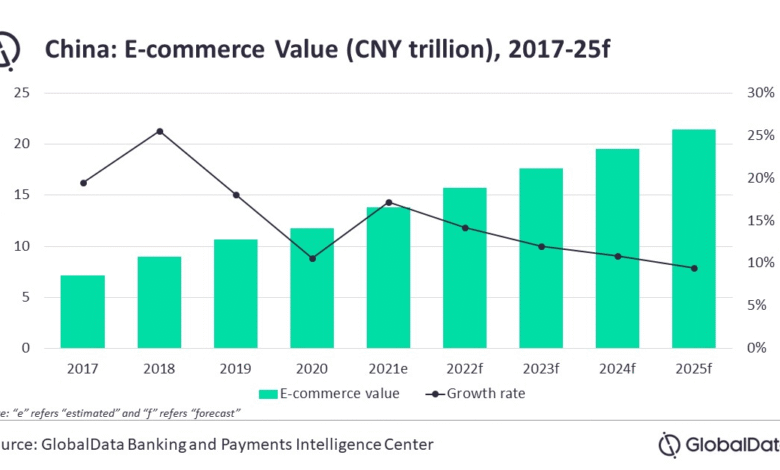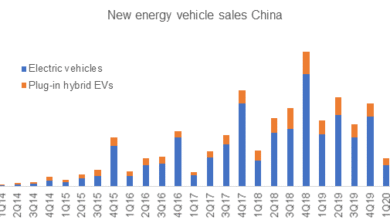Chinese E-commerce Growth: Alibaba, Tencent, and JD.com Earnings

Chinese e-commerce growth continues to impress as major players like Alibaba, Tencent, and JD.com report stronger-than-expected earnings amid fluctuating consumer spending patterns. This week’s earnings releases not only highlight improved sales figures but also underscore the effectiveness of AI in advertising, which has become a pivotal factor driving revenue increases across the sector. Alibaba’s report showcased a remarkable year-on-year growth of 9%, transcending analyst projections and indicating a resilient market despite external pressures from U.S.-China trade tensions. In particular, the robust performance in sectors such as electronics aligns with a rebound in China consumer confidence, which, despite recent declines, hints at a potential recovery. As these companies adapt and innovate, particularly through AI technologies, the outlook for e-commerce in China remains optimistic, paving the way for further developments and opportunities.
The remarkable expansion of online retailing in China signifies a crucial evolution in consumer behavior and sector dynamics. Notable enterprises like Alibaba, JD.com, and Tencent are at the forefront of this digital marketplace transformation, not only showcasing impressive sales reports but also leveraging advanced technological solutions such as artificial intelligence in their marketing strategies. This ongoing shift reflects an overall uptick in consumer activity, highlighted by revenue surges despite external economic pressures. As the digital commerce landscape flourishes, alternative methods are being embraced to enhance advertising efficacy and consumer engagement, fundamentally reshaping the way businesses connect with buyers. Ultimately, the Chinese online retail ecosystem’s ability to adapt to challenges will play a pivotal role in sustaining its growth momentum.
The Impact of Chinese E-Commerce Growth on Major Players
The recent reports from Alibaba, Tencent, and JD.com underline a significant trend in the realm of Chinese e-commerce growth. As these companies navigate challenges posed by fluctuating consumer confidence and trade disputes, their ability to adapt has been striking. Alibaba reported a commendable 9% year-on-year growth in their Taobao and Tmall segments, reinforcing their leading position in the e-commerce space. This growth not only highlights the resilience of Chinese consumers but also emphasizes the rapidly shifting dynamics in online retail across China.
JD.com’s impressive 16.3% increase in revenue from its retail business showcases similar resilience amidst broader economic challenges. This signifies a transformative era where technology, particularly AI tools, plays a pivotal role in enhancing customer engagement and driving sales conversions. With the e-commerce market continuing to expand despite external pressures, these major players are set to redefine the parameters of competition in the sector.
Chinese Consumer Confidence and Its Effect on E-Commerce
Recent surveys indicate a decline in Chinese consumer confidence, reaching a 2.5-year low, particularly following heightened trade tensions with the U.S. This dip is crucial as it directly influences consumer spending behavior, which is paramount for e-commerce platforms like Alibaba and JD.com. Strategies aimed at restoring consumer confidence will be essential for sustaining growth momentum within these companies. As Kai Wang of Morningstar highlighted, the expectations surrounding consumer behavior were previously cautious due to tariff implications.
The importance of maintaining consumer trust cannot be overstated for e-commerce businesses as they rely heavily on repeat purchases and customer loyalty. The challenge lies in balancing tariffs and marketing efforts to re-engage hesitant consumers. Reinventing advertising strategies through AI could potentially play a role in regaining lost consumer confidence as companies like Tencent demonstrate marked revenue growth by enhancing user engagement.
The Role of AI in Chinese Advertising
Artificial Intelligence is reshaping the advertising landscape in China, significantly impacting the performance of companies such as Tencent and JD.com. With click-through rates soaring to nearly 3%, the effectiveness of AI-driven ad campaigns is becoming increasingly evident. This surge not only reflects the efficacy of digital marketing strategies but also highlights the growing expectation of dynamic and personalized ad experiences for consumers across digital platforms.
Moreover, JD.com’s 15.7% growth in marketing revenue can largely be attributed to the deployment of AI tools that enhance ad conversion rates. As marketers engage in more targeted campaigns utilizing sophisticated data analytics and consumer insights, the potential for sustainable advertising growth intensifies. The adoption of AI solutions in the advertising domain could be the key differentiator that aids these companies in navigating the complex landscape of consumer behavior amid shifting economic circumstances.
The Earnings Reports: A Reflection of Market Trends
The latest earnings reports from Alibaba, Tencent, and JD.com not only showcase individual performance metrics but also reflect broader market trends in China’s evolving e-commerce landscape. Alibaba’s growth in the Taobao and Tmall segments indicates a robust framework for online retail, suggesting that despite macroeconomic challenges, consumer demand is still alive and well. Analysts had predicted lower figures, particularly in light of trade tensions, which makes these results a positive surprise.
On the other hand, JD.com’s strong revenue figures are indicative of successful strategic adaptations, especially in categories like electronics and home appliances, which benefit from government trade-in subsidies. This divergence in performance showcases the importance of sector-specific strategies, illuminating how different segments within the retail framework can contribute to overall growth even when the market is under pressure.
Trade Tensions and Their Implications for E-Commerce
The ongoing U.S.-China trade tensions pose a significant threat to the stability of Chinese e-commerce giants. As tariffs escalate and consumer confidence wavers, businesses must adapt quickly to mitigate potential losses. While recent data shows that Alibaba, Tencent, and JD.com have managed to report encouraging figures, the looming uncertainties surrounding international trade could dampen future growth prospects. According to analysts, the trade dispute has already begun to affect consumer habits, prompting strategic shifts in marketing and product offerings.
Despite these challenges, there is a silver lining in that companies are increasingly turning towards innovative solutions like artificial intelligence to drive efficiency and enhance customer experiences. This strategic pivot exemplifies a broader trend across the e-commerce industry to not only weather the storm but emerge stronger by leveraging technology. As trade tensions evolve, companies that prioritize adaptability and consumer focus may find themselves leading the charge in an ever-changing marketplace.
Future Opportunities in the E-Commerce Landscape
Looking ahead, the Chinese e-commerce sector is poised for opportunities, despite current challenges in consumer confidence and trade tensions. Events such as promotions and holiday sales are anticipated to rejuvenate spending, as consumers may be eager to return to spending once they feel assurances from economic stability. This optimistic outlook is crucial for investors and businesses alike, as sustained growth in this sector can counterbalance broader economic slowdowns.
In addition, companies are focusing more on optimizing their digital marketing efforts through AI, suggesting that future growth may increasingly hinge on technological advancements. For instance, enhanced data analytics can help tailor offerings that align closely with consumer preferences, creating a compelling case for higher engagement and conversion rates. The blend of innovative marketing strategies and responsive consumer outreach will be central to unlocking growth potential in the coming years.
Market Predictions and Earnings Forecasts
As analysts delve deeper into forecast predictions for the retail sector, there is a palpable tension between optimism and caution. Companies like Alibaba and JD.com are facing scrutiny regarding their future earnings, especially given their recent performance metrics. While Alibaba fell short of profit expectations, JD.com’s growth patterns suggest a more resilient path forward. Future retail sales data is expected to provide critical insights into consumer behavior trends in response to broader economic signals.
With China poised to make announcements regarding retail growth and stimulus measures, stakeholders are watching closely. These forthcoming insights could elucidate how e-commerce giants will adapt their strategies and operations in the next quarter. A careful approach, focusing on technology and consumer sentiment, could steer these companies back towards more favorable earnings outcomes, demystifying the ongoing complexities rooted in consumer confidence and trade dynamics.
Marketing Innovations in the Face of Economic Challenges
As Chinese e-commerce companies grapple with economic uncertainty, marketing innovation remains a crucial focus. The introduction of AI in marketing strategies is not just an option but a necessity for survival in a competitive landscape. Alibaba and JD.com are leveraging advanced technologies to drive their advertising campaigns, which are becoming increasingly personalized and targeted. Such innovations are not mere trends but essential pivots that could dictate the trajectories of these companies in a fluctuating market.
Moreover, Tencent’s success with its marketing services highlights the appetite for content-driven advertising, where engaging short videos capture consumer interest. The rapid evolution of consumer expectations necessitates that companies stay ahead by continuously exploring and adopting cutting-edge marketing techniques. As the connection between technology and advertising deepens, the potential for enhanced consumer engagement and loyalty strengthens, paving the way for future growth.
Consumer Behavior Trends and E-Commerce Dynamics
Understanding consumer behavior is integral to predicting the course of e-commerce in China. The recent downturn in consumer confidence, as indicated by surveys, suggests that a reset in purchasing habits may be underway. E-commerce platforms must closely monitor these trends, as transitional consumer attitudes can result in vast shifts in market demands. The companies that can interpret these signals effectively will position themselves favorably, adjusting offerings and marketing strategies according to evolving expectations.
In response to these changing dynamics, operations within these e-commerce giants will need to become increasingly data-driven. Employing AI and analytics to decipher consumer insights can provide actionable strategies for enhancing user experience and ensuring loyalty. As consumer behaviors evolve in a landscape shaped by both domestic factors and international pressures, adaptability and responsiveness remain crucial for sustained success in the highly competitive e-commerce environment.
Frequently Asked Questions
How are Alibaba earnings reflecting the growth of Chinese e-commerce?
Alibaba’s recent earnings report showcased a significant 9% increase in sales for its Taobao and Tmall platforms, reaching 101.37 billion yuan. This growth is indicative of the resilience and continued expansion of Chinese e-commerce amidst economic challenges.
What does Tencent’s revenue increase signify for Chinese e-commerce growth?
Tencent reported a 5% year-on-year increase in its fintech and business services, highlighting the importance of digital platforms in enhancing Chinese e-commerce growth, particularly through effective advertising strategies.
What does the JD.com sales report indicate about the state of Chinese e-commerce?
JD.com posted a remarkable 16.3% revenue increase, showing that despite economic pressures, segments of Chinese e-commerce are thriving, especially in retail categories bolstered by government trade-in subsidies.
How is AI in advertising contributing to the growth of Chinese e-commerce?
AI has been instrumental in boosting advertising efficiencies for companies like Tencent and JD.com, leading to higher click-through rates and improved conversion rates, which are essential for driving growth in Chinese e-commerce.
How does China consumer confidence affect the outlook for e-commerce growth?
According to recent surveys, consumer confidence in China hit a 2.5-year low, which poses challenges for e-commerce growth. However, improving earnings from e-commerce giants like Alibaba and JD.com may signal a potential rebound in consumer spending.
What role do tariffs play in the growth of Chinese e-commerce?
The ongoing U.S.-China trade tensions and tariffs have introduced uncertainty into consumer behavior, impacting Chinese e-commerce growth. However, reports suggest that as these tensions ease, consumer spending may improve, benefitting e-commerce firms.
What are the future prospects for Chinese e-commerce growth in light of current economic challenges?
While current trends show promise for Chinese e-commerce growth, the overall outlook remains cautious due to lingering trade disputes and falling consumer confidence. Companies may need to leverage AI and innovative marketing strategies to navigate these challenges effectively.
| Key Points |
|---|
| Alibaba, Tencent, and JD.com reported earnings reflecting improving Chinese consumer spending and AI advantages in advertising. |
| Despite expectations of tariff impacts on consumer behavior, e-commerce and ad revenues surprised positively according to Kai Wang from Morningstar. |
| A Morgan Stanley survey indicated a drop in consumer confidence to a 2.5-year low amid US-China tensions. |
| Alibaba’s Taobao and Tmall sales increased by 9% year-on-year, surpassing analyst predictions, showing healthy growth in e-commerce. |
| US-China trade dispute has affected consumption, although a reduction in tensions may boost spending, according to Charlie Chen. |
| Specific electronics and home appliances thrive due to trade-in subsidies while JD.com reported a 16.3% revenue increase. |
| Tencent’s marketing revenue surged by 20%, benefiting from AI-enhanced advertising effectiveness in their services. |
| Uncertainty remains about consumer spending and growth in the retail sector as Alibaba’s profits fell short of expectations. |
Summary
The growth of Chinese e-commerce is currently influenced by a combination of improving consumer spending and the effective use of artificial intelligence in advertising. Despite the recent downturn in consumer confidence due to US-China trade tensions, companies like Alibaba, Tencent, and JD.com are showcasing remarkable resilience and performance in their earnings reports. It’s essential for stakeholders to closely monitor these developments, as upcoming promotional events and shifts in trade relations may further shape the landscape of Chinese e-commerce growth.




